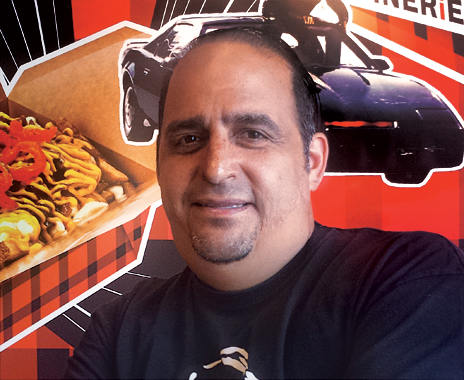Before serving poutine—the Canadian favorite consisting of french fries, gravy, and cheese curds—Danny Rodriguez was all about show business. After graduating with a degree in film studies from the University of California at Santa Barbara, Rodriguez opened his own company under an output deal with Warner Brothers and distributed close to 80 films over an eight-year span. He also headed acquisition and marketing for independent films within the company. After selling the company in 2008, Rodriguez produced seven Showtime specials and 12 feature films.
On the set of Bravetown in Winnipeg, Canada, Rodriguez had his first taste of Smoke’s Poutinerie after a long night of shooting. Noticing the constant long lines outside the restaurant, Rodriguez began speaking with Smoke’s founder Ryan Smolkin about bringing the brand to the U.S. He opened his first unit in Berkeley, California, in 2014 and has plans for new locations, as well as a food truck.
Still active in the film industry, Rodriguez leverages his Hollywood know-how by treating his restaurants like film premieres.
1. Treat your brand like a star
I remember looking for business opportunities that might be more consistent income than the film industry, and had no intention of that being an opportunity in the quick-serve industry. On the set for Bravetown, I fell in love with Smoke’s Poutinerie, and it was clear that I was late to the party. The location we went to was always busy, sometimes with a line out the door. It was one of the best new things I had ever tried.
I was so amazed by the brand, and I immediately wanted to look into new areas and possibly bring it into the U.S. I didn’t know what it meant to be a franchisee—or a lot about the quick-serve industry in general—but I knew I wanted to be part of this brand. I think if anyone wants to get into this industry, that type of connection should be there. The product should excite you, and I immediately had that with Smoke’s.
Having been involved in marketing and branding with the film industry, I looked at what the owner, Ryan Smolkin, was doing, and I really wanted to be involved. Since then, it’s been an incredible collaboration with corporate and relationship with Ryan. I think if I jumped in with another brand simply to get into franchising, it would have been a completely different experience. The brand has supported me, and I feel like an integral part of the brand and its future. A prospective franchisee should feel that sense of passion and comradery for the brand and products it has to offer.
2. Plug your product on the streets
When dealing with the independent film world, I really had to stretch out the dollar when it came to marketing. Some big-budget films might get around $2 million to promote the film, whereas I would get somewhere around $2,000. As soon as I knew the location of my first Smoke’s unit, I immediately started a marketing campaign promoting the brand the same way I would promote a film. We hit heavy on social media, sought out the student base on campuses, and got connected with social groups networking with late-night restaurants and people across a variety of social media platforms. We also started a street campaign—which is what I did for independent films before social media—and passed out postcards, flyers, and stickers.
This was a daily routine of getting connected with the community for about five months before opening. The brand itself and its logo merits the type of viral visualization you can get from plastering stickers everywhere. It seemed that there was a Smoke’s sticker or flier everywhere around the city.
3. Take the brand viral
We ended up with a lot of followers across all of our social media efforts. We even went as far as giving away Smoke’s T-shirts and having people walk around town with them, and if anyone asked, the model would pull out a menu from Smoke’s right on the spot and educate. That’s what our efforts turned into.
Since we were successful in the promotion of the brand, we then had the opportunity to follow up and educate thereafter. Putting all of our followers together on a fan page, we began creating videos and entertainment clips about poutine and its popularity. Given we were in a new market, it was crucial to have product awareness and the popularity behind it. For example, one video we put up was a marketing promotion for the film This is the End starring Seth Rogen. In it, Seth Rogen explains that if he was faced with a “last meal” scenario, it would be poutine, and the product they were eating in the video was from Smoke’s. Being able to integrate that sort of brand education and buzz with our already dedicated followers and fans was essential.
I tried to create the opening of the store as the opening night of an independent film, and we were lucky enough to have around 1,200 people in line our first night. It’s been so rewarding to see, because, unlike the completion of a film and the release a year later, I get to see the customer’s immediate reaction.





